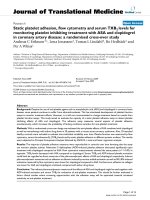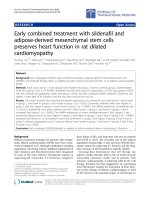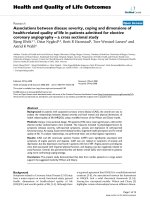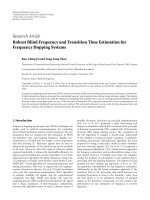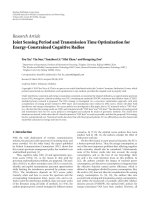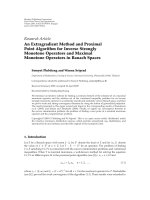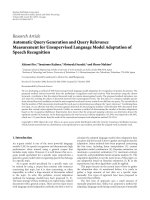Báo cáo hóa học: " A Sigma-Delta ADC with Decimation and Gain Control Function for a Bluetooth Receiver in 130 nm Digital CMOS" pdf
Bạn đang xem bản rút gọn của tài liệu. Xem và tải ngay bản đầy đủ của tài liệu tại đây (1.59 MB, 8 trang )
Hindawi Publishing Corporation
EURASIP Journal on Wireless Communications and Networking
Volume 2006, Article ID 71249, Pages 1–8
DOI 10.1155/WCN/2006/71249
A Sigma-Delta ADC with Decimation and Gain Control
Function for a Bluetooth Receiver in 130 nm Digital CMOS
Jinseok Koh, Gabriel Gomez, Khurram Muhammad, R. Bogdan Staszewski, and Baher Haroun
Wireless Analog Technology Center, Texas Instruments Inc., Dallas, TX 75243, USA
Received 25 October 2005; Revised 15 April 2006; Accepted 18 April 2006
We present a discrete-time second-order multibit sigma-delta ADC that filters and decimates by two the input data samples. At
the same time it provides gain control function in its input sampling stage. A 4-tap FIR switched capacitor (SC) architecture was
chosen for antialiasing filtering. The decimation-by-two function is realized using divided-by-two clock signals in the antialiasing
filter. Antialiasing, gain control, and sampling functions are merged in the sampling network using SC techniques. This compact
architecture allows operating the preceding blocks at twice the ADC’s clock frequency, thus improving the noise performance of
the wireless receiver channel and relaxing settling requirements of the analog building blocks. The presented approach has been
validated and incorporated in a commercial single-chip Bluetooth radio realized in a 1.5 V 130 nm digital CMOS process. The
measured antialiasing filtering shows better than 75 dB suppression at the folding frequency band edge. A 67 dB dynamic range
was measured w ith a sampling frequency of 37.5 MHz.
Copyright © 2006 Jinseok Koh et al. This is an open access article distributed under the Creative Commons Attribution License,
which permits unrestricted use, distribution, and reproduction in any medium, provided the original work is properly cited.
1. INTRODUCTION
Discrete-time analog signal processing approaches for Blue-
tooth wireless receivers have been proposed and successfully
implemented [1, 2]. These receivers employ a discrete-time
architecture in which the RF signal is directly sampled and
filtered using analog and digital signal processing techniques.
Although sampling close to the front-end may render the
receiver architecture more susceptible to noise folding and
clock jitter effects, it also provides significant advantages that
make this technique very attractive.
From the RF wireless system point of view, integrating
analog building blocks and digital baseband circuits on the
same chip helps to reduce area and power consumption, thus
driving down the total system cost. Advanced digital CMOS
technology provides very high-speed switching devices, thus
allowing discrete-time circuits to be clocked at very high
rates. Additionally, it is well known that these digital CMOS
processes show component matching as good as or even bet-
ter than traditional analog processes, even though absolute
component value may present big spread over process cor-
ners.
The approach shown in Figure 1 [1, 2] takes advantage
of this system and CMOS process characteristics by directly
sampling the RF signal after the LNA and subsequent pro-
cessing that exploits the precise capacitance ratios that set
the filtering coefficients. Total noise due to folding can be
minimized by sampling at a very high rate compared to the
input signal bandwidth. This is achieved in the direct sam-
pling mixer (DSM) which samples the RF signal at RF carrier
rate, while down-converting and integrating it in a sampling
capacitor. In order to realize the direct sampling, the DSM
clocking frequency must be kept high at RF, while, at the
same time, the ADC data rate should be kept low in order to
reduce power dissipation and to allow for sufficient settling
time to the input signal. Thus, an ADC that provides data
rate conversion and signal amplification in the input sam-
pling stage becomes very advantageous. Figure 2 represents a
basic idea for this approach.
In this paper, we present such an approach, which has
been implemented and verified in a 130 nm digital CMOS
process. The organization of this paper is as follows. Section
2 presents the receiver architecture. The sigma-delta ADC de-
sign and the proposed built-in antialiasing filter merged into
sampling network a re described in Section 3.Measurements
and implementation are presented in Section 4.Performance
summary and conclusions are covered in Section 5.
2. RECEIVER ARCHITECTURE
The amount of interferer filtering performed in the front-
end establishes the ADC dynamic range (DR) specification
2 EURASIP Journal on Wireless Communications and Networking
AGC MTDSM AGC Sigma-delta ADC
2400 MS/s 300 MS/s 75 MS/s 37.5MS/s
LNA TA Sampler
Sinc
filter
8
Filter
IIR/sinc
4IFA
Sinc
3
filter
2ADC
ADPLL DCU PCU
CLK
Digital
receive
chain
Bits
TA Sampler
Sinc
filter
8
Filter
IIR/sinc
4IFA
Sinc
3
filter
2ADC
LNTA MTDSM AGC Sigma-delta ADC
Figure 1: A discrete-time RF wireless receiver [1, 2].
Input
FIR filter
Decimation
by 2
Buffer
2 x1
Sigma-delta
ADC
3bit
out
Figure 2: Typical building blocks for what would be required for
decimation and gain control.
V
in
2 Σ
+
z
1
1 z
1
a2 Σ
+
z
1
1 z
1
b1 b2
ILA Decoder
3bit
out
Figure 3: Proposed sigma-delta ADC architecture.
to a minimum of 60 dB. In [3, 4], it was shown that a 5-
level second-order sigma-delta ADC can achieve this DR at
a F
s
= 37.5 MHz sampling frequency while maintaining a
low power dissipation. The block diagram in Figure 3 shows
the 3-bit sigma-delta architecture with the built-in antialias-
ing filter. This multibit architecture relaxes the first integra-
tor’s amplifier requirements, thanks to the reduced signal
changes at the amplifier’s output when compared to a single-
bit sigma-delta ADC. Also, the required full signal swing at
this node is reduced, resulting in a relaxed settling time and
slew rate specifications. This also results in area and power
savings, since a single-stage low-voltage and low-power am-
plifier can be used for the implementation.
Two issues need to be carefully considered for the ADC
system design. First, since decimation causes noise folding,
an antialiasing filter is required. This filter is implemented
using an FIR sw itched capacitor structure. Second, from the
Bluetooth system requirements, there is a need for an au-
tomatic gain control (AGC) function. Providing some gain
control at the input of the ADC helps distributing the AGC
function between the ADC and the intermediate frequency
amplifier (IFA), thus relaxing the IFA spe cification and opti-
mizing power consumption.
A hypothetical conventional solution, as shown in Figure
2 would require an isolation buffer between the FIR filter and
the ADC input sampling stage in order to avoid charge shar-
ing between the two switched capacitor blocks. T his buffer
would also provide the required AGC functionality. How-
ever, this amplifying stage would have very demanding set-
tling time requirements to reduce the error at the sampling
instant in the ADC input stage. In addition, it would increase
area and power consumption.
The FIR filtering, decimation-by-two, and gain control
functions are all implemented in the sampling network at
the input of the ADC. As shown in Figure 3, combining
these functions in a single sampling structure optimizes area,
power, and complexity.
3. SIGMA-DELTA ADC DESIGN
3.1. FIR antialiasing filter and decimation
The diagram in Figure 4 shows a switched capacitor imple-
mentation of the sampling network, but, for the sake of clar-
ity at this point, it does not include the gain control func-
tion. Since the supply voltage is 1.58 V, that is, above 1.4 V
of the nominal supply to ensure good transconductance, all
switches are realized as regular NMOS devices with nomi-
nal V
T
= 600 mV. The key role of the FIR filter is to provide
enough noise suppression around F
s
/2. The signal at the in-
put of the ADC is naturally band-limited to 75 MHz by the
preceding circuits. The ADC works at half that frequency. A
4-tap charge-domain FIR filter is implemented to attenuate
the input signal noise around 37.5 MHz. The FIR order was
determined by system level simulations. The FIR filter differ-
ence equation is given by
C
M
· y[n] = C
0
· x[n]+C
1
· x[n − 1]
+ C
2
· x[n − 2] + C
3
· x[n − 3],
(1)
where coefficients C
0
, C
1
, C
2
,andC
3
are1,3,3,and1,respec-
tively, which can be easily implemented as capacitor ratios.
Jinseok Koh et al. 3
Input
P1
P1
P4
P4
I1
C
p1
3C
p1
C
p4
3C
p4
I2
I3
I2
I1
P1
P1
P4
I2
I3
I2
P4
P2
P2
P5
P5
C
p2
3C
p2
C
p5
3C
p5
I1
P2
I3
P2
I1
P5
I2
P5
I1
I3
I1
I2
P3
P3
P6
P6
C
p3
3C
p3
C
p6
3C
p6
I3
I1
I3
I2
I3
I1
I3
I2
P3
P3
P6
P6
C
M
+
+
5level
DAC
V
refp
V
refm
Figure 4: Four-tap FIR filter implementation.
100
80
60
40
20
0
20
Power spectrum magnitude (dB)
00.511.522.533.5
10
7
Frequency
FIR filter frequency response
Figure 5: Output power spectrum density for FIR filter with white
noise input.
The plot in Figure 5 shows the FIR output power spectral
density with white noise applied as input. Matlab simulations
indicate that more than 80 dB attenuations can be achieved
at the folding frequency band edge (36.5 MHz, since 1 MHz
is the signal bandwidth).
Capacitor mismatches in the FIR filter can possibly cause
distortion and unwanted modulation. In order to reduce this
effect, dynamic element matching techniques can be em-
ployed with additional switched capacitor circuits. However,
these extra circuits increase area. Another way to minimize
this effect is to use bigger unit capacitance which has gener-
ally better matching. Thanks to the good matching property
of the CMOS process, 10 bit matching can be easily achieved
P1
P2
P3
P4
P5
P6
I1
I2
I3
Figure 6: Control signals for the FIR filter.
without dramatically increasing unit capacitance. Based on
behavioral-level simulations, the minimum allowable c apac-
itance value was chosen. Six-phase clock signals are utilized
to realize both the FIR filter and the decimation functions.
On P1 phase, the input signal is sampled in C
p2
and 3C
p1
,
on P2 phase, it is sampled in C
p2
,and3C
p2
, and on Pi phase,
the input is sampled into C
pi
and 3C
pi
,withi = 1, ,6.Af-
ter P6, the process is repeated back from P1 phase. On I1
integrating phase, charge in capacitors C
p2
,3C
p3
,3C
p4
,and
C
p5
is dumped into the integrating capacitor C
M
. As shown
in the timing diagram in Figure 6, integration occurs in P1,
P3, and P5 phases only (with corresponding signal names I1,
I2, and I3). Since there could be no integration for P2, P4,
or P6 phases, decimation-by-2 operation is achieved. To in-
crease the time available for integrator settling, integrating
control signals’ I1, I2, and I3 duty cycle is extended as shown
in Figure 6.
4 EURASIP Journal on Wireless Communications and Networking
High gain mode
LG
C
sh
HG
C
M
Input
N1
C
s
N2
+
+
N2 N1
Figure 7: Gain control in the FIR filter.
0
100
200
300
400
500
600
Noise (uV
rms
)
564
noise
tot
561
quant.
75
amp.
18.8
kT/C
18
ref
Noise sources
Conditions:
1. Fs
= 37.5MHz
2. BW
= 1MHz
3. 5 level flash
Figure 8: Noise analysis.
3.2. Gain control
Figure 7 shows how the two-step (0 dB and 14 dB, derived
from the Bluetooth RX system specifications) gain control
function is implemented using switched capacitor circuits.
When the switch HG turns on, the 14 dB gain mode is ac-
tivated.Whenthe0dBmodeisactivated,switchLGturns
on instead of switch HG. The total gain is simply defined
by the ratio between the sampling and the integrating ca-
pacitors. This function is implemented in the FIR sampling
block by adding the high-gain-mode switched capacitor in
parallel with each of the capacitors in Figure 4. An alterna-
tive of adding the capacitance in the amplifier feedback is
not the best choice since it would change the amplifier gain-
bandwidth (GBW) product. The load capacitance at the IFA
output is an important design parameter, since it affects the
GBW product as well as the slew rate of the amplifier. There-
fore, both gain modes should provide the same lo ad condi-
tion to the IFA output. As shown in Figure 7, the capacitance
seen at the input port is kept constant for both gain modes.
In order to minimize the sampling error due to charge in-
jection and clock feed-through from the switches, transistor
sizes are optimized for speed and area. Figure 8 shows the
VDDA
V
b1
V
b2
V
b2
OutM
OutP
Inp Inm
V
b3
V
b3
V
b4
VSSA
Figure 9: Folded cascode amplifier.
noise analysis for the proposed ADC. Quantization noise is
a dominant noise contributor for this application due to the
low oversampling ratio (OSR), making kT/C noise less of an
issue. Therefore, the unit capacitance element in the FIR fil-
ter is selected based mainly on the effect of mismatch on the
ADC performance.
3.3. Amplifier, comparator, and DAC
A folded cascode fully differential amplifier with a switched
capacitor common mode feedback is used [5]. Amplifier
noise is optimized on the basis of power consumption and
area. However, as in the case of kT/C noise, noise from the
amplifier is not very c ritical due to the high in-band quanti-
zation noise. Therefore slew rate, GBW, and output dynamic
range became the most critical design parameters. Since the
sigma-delta ADC has to work in the same subst rate as the
digital core, digital circuit noise coupling through the sub-
strate and supply rails was carefully considered as an impor-
tant design and layout parameter. Layout considerations are
also very critical, since any component mismatch could result
in degradation of common-mode noise rejection and cancel-
lation. Also, great care was taken to provide enough guard
ringing and supply decoupling. The final amplifier configu-
ration is shown in Figure 9, which does not include the com-
mon mode feedback or the bias circuits.
A five-level quantizer is implemented using four compa-
rators to build a flash ADC. The flash ADC utilizes switched
capacitor subtraction in order to generate four different
threshold voltages. The simplified comparator circuits for
one of the flash’s four stages, including subtraction circuits,
are depicted in Figure 10.
The 5-level (+2, +1, 0,
−1, −2) DAC is implemented us-
ing four switched capacitor elements that keep constant the
capacitor loading at the input of the amplifier, independently
Jinseok Koh et al. 5
VINP
REFP
VINM
REFM
N1 N2
C
i
C
r
C
i
C
r
N2
N2
+
+
COMP
OutM
OutP
Latch
Figure 10: Switched capacitor comparator.
0.8
0.6
0.4
0.2
0
0.2
0.4
0.6
0.8
Output
11.522.533.544.55
Input
DAC response
Ideal
Set1
Set2
(a)
0.8
0.6
0.4
0.2
0
0.2
0.4
0.6
0.8
Output
11.522.533.544.55
Input
DAC response
Ideal
Set1
Set2
(b)
Figure 11: Transfer functions.
of the quantizer output. Two DAC elements could have been
used for a 5-level DAC realization, but the load capacitance
would be different for the case when quantizer output is +1
or
−1 versus the case when it is +2, 0 , and −2. In order to
suppress nonlinearities generated in the 5-level switched ca-
pacitor DAC, the individual level averaging (ILA) algorithm
is used [3, 6]. Any possible distortion from the capacitor mis-
match in the 5-level DAC is translated into gain error by the
ILA algorithm. This phenomenon is depicted in Figure 11.
Two worst-case mismatch conditions were chosen and veri-
fied in behavioral and SPICE simulations. Figure 11(a) shows
the 5-level DAC transfer function by using two worst-case
mismatch conditions. Figure 11(b) shows a DAC transfer
function when ILA is used to liberalize the DAC transfer
function. In order to visualize the effect from capacitor mis-
match clearly, unrealistic matching numbers were used to
generate the plot in Figure 11.
4. EXPERIMENTAL RESULTS
The 3-bit sigma-delta AD C output was captured using a
high-frequency DSP-based data acquisition system. The dy-
namic performance was obtained by post-processing the cap-
tured data through an FFT and computing various perfor-
mance numbers. Figure 12 is the measured FIR filter re-
sponse with a
−6 dBFS input sinusoidal signal applied to the
ADC at frequency steps of 1 MHz from 1 MHz to 30 MHz.
The measurement results are well matched to the theoreti-
cal curve of the FIR antialiasing filter, as can be seen in the
plot. The gain of the filter response is slightly less than the
theoretical number due to the gain error induced from non-
idealities in the integrator, reference buffer, and SC DAC.
The power spec tral density plot in Figure 13 shows the sys-
tem performance when two signals (0 dB at 37 MHz and
−6 dB at 275 kHz) are applied together. By sampling theory,
6 EURASIP Journal on Wireless Communications and Networking
80
70
60
50
40
30
20
10
0
10
Magnitude (dB)
00.511.522.533.5
10
7
Frequency (Hz)
Antialiasing FIR filter response
Theoretical response
Measurements
Figure 12: Measured transfer function.
140
120
100
80
60
40
20
0
Power spectrum density (dB)
10
3
10
4
10
5
10
6
10
7
Frequency (Hz)
Figure 13: Spectrum of the captured output.
this should cause a folding signal at 500 kHz (37.5 MHz (F
s
)
−37 MHz), but as the figure shows, it is filtered and attenu-
ated below the quantization noise floor.
The interferers in communication systems need to be
carefully taken into account especially in cases where sys-
tem nonlinearities may create intermodulation. Due to ADC
nonlinearities, an interferer can be folded into the Bluetooth
signal bandwidth by means of intermodulation. Figure 14
shows the measured FFT plot for an intermodulation test.
Two
−8 dBFS sinusoidal signals at 1 MHz (F
1
)and2.2MHz
(F
2
) are applied. A −80 dBc IM3 signal appears at 200 kHz.
The measured IM3 satisfies and exceeds the system require-
ments. Figure 15 shows the measured SNDR versus input
amplitude for 0 dB and 14 dB gain modes. The measured
140
120
100
80
60
40
20
0
Power spectrum density (dB)
10
3
10
4
10
5
10
6
10
7
Frequency (Hz)
IM3
f
1
= 1MHz f
2
= 2.2MHz
Figure 14: Two-tone test measurement.
0
10
20
30
40
50
60
70
SNDR (dB)
70 60 50 40 30 20 10 0
Input amplitude (dBFS)
SNDR versus input
0dBgainmode
14 dB gain mode
Figure 15: Measured SNDR versus input power.
peak SNDR is 60 dB for an input 4 dB from full scale with a
1 MHz bandwidth, where the full scale is defined as twice the
reference voltage. Table 1 shows the performance summary
of the implemented ADC. Die photo for the dual channel
implementation is shown in Figure 16.
5. CONCLUSION
A discrete-time second-order 5-level sigma-delta ADC has
been successfully implemented and characterized in a 1.5 V
130 nm digital CMOS technolog y. The built-in antialiasing
filter and a two-step gain control are merged into the sam-
pling network. The decimation-by-two function relaxes the
settling requirements of the amplifier. The two-step gain
control increases the overall dynamic range and also relaxes
the automatic gain control burden in the Bluetooth system
Jinseok Koh et al. 7
Table 1: Performance summary.
Technology 130 nm digital CMOS
Sampling frequency 37.5 MHz
Signal bandwidth
1MHz
Peak SNDR (0 dB gain option)
60 dB
Peak SNDR (14 dB gain option)
57 dB
Dynamic range
67 dB
Overall dynamic range
77 dB
Input range
1.4 V
pp
(diff)
Supply voltage
1.58 V
Power consumption
1.6 mW
Core area
0.2 mm
2
ADC
DAC
MTDSM
Figure 16: Micrograph of the dual channel ADC.
implementation. Since the quantization noise is the domi-
nant factor due to the low oversampling ratio and the kT/C
noise and amplifier noise are not critical, the power con-
sumption in the ADC system was optimized, which resulted
in saving area and current consumption. The total area in-
cluding the switched capacitor sampling network is 0.2mm
2
per ADC channel. The consumed power is 1.6 mW per chan-
nel at a 1.58 V supply. The achieved dynamic performance
fully satisfies the system requirements for a Bluetooth re-
ceiver. The presented architecture can be easily extended to
higher decimation ratios and better gain control resolution,
while the FIR filter can be easily adjusted for different modes
or system requirements.
ACKNOWLEDGMENTS
The authors would like to thank B. Bakkaloglu for discussion
and comments and to W. E. Kim and H. S. Kim for support
in device testing and characterization.
REFERENCES
[1] K. Muhammad, D. Leipold, B. Staszewski, et al., “A discrete-
timeBluetoothreceiverina0.13μm digital CMOS process,” in
Proceedings of IEEE International Solid-State Circuits Conference
(ISSCC ’04), vol. 1, pp. 267–269, 527, San Francisco, Calif, USA,
February 2004.
[2] R. B. Staszewski, K. Muhammad, D. Leipold, et al., “All-digital
TX frequency synthesizer and discrete-time receiver for Blue-
tooth radio in 130-nm CMOS,” IEEE Journal of Solid-State Cir-
cuits, vol. 39, no. 12, pp. 2278–2291, 2004.
[3] G. Gomez and B. Haroun, “A 1.5 V 2.4/2.9 mW 79/50 dB DR
ΣΔ modulator for GSM/WCDMA in a 0.13 μm digital process,”
in Proceedings of IEEE International Solid-State Circuits Confer-
ence (ISSCC ’02), pp. 242–243, 490, San Francisco, Calif, USA,
February 2002.
[4]J.Koh,K.Muhammad,B.Staszewski,G.Gomez,andB.
Horoun, “A sigma-delta ADC with a built-in anti-aliasing filter
for Bluetooth receiver in 130nm digital process,” in Proceedings
of IEEE Custom Integrated Circuits Conference (CICC ’04),pp.
535–538, Orlando, Fla, USA, October 2004, sec. 25-6.
[5] H. C. Yang, M. A. Abu-Dayeh, and D. J. Allstot, “Analysis and
design of a fast-settling folded-cascode CMOS operational am-
plifier for switched-capacitor applications,” in Proceedings of the
32nd Midwest Symposium on Circuits and Systems, vol. 1, pp.
442–445, Champaign, Ill, USA, August 1989.
[6] B. H. Leung and S. Sutarja, “Multibit Σ-Δ A/D converter in-
corporating a novel class of dynamic element matching tech-
niques,” IEEE Transactions on Circuits and Systems II, vol. 39,
no. 1, pp. 35–51, 1992.
Jinseok Koh wasborninSeoul,Korea,in
1968. He received his Ph.D. degree in elec-
trical engineering from Texas A&M Univer-
sity in 2000. From 1993 to 1996, he was
with Samsung Electronics as a Design En-
gineer working on the high-speed BiCMOS
SRAM. When he was at Texas A&M Univer-
sity, he was with Analog Mixed Signal Cen-
ter working on the sensor-based circuit im-
plementations and modeling of nonideali-
ties in data converters. He has developed an LMS-based sigma-delta
ADC. He joined Texas Instruments in 2000, where he is working on
transceiver designs for wireless applications. His interest is on the
sigma-delta ADCs, high-speed DACs, and transceiver architectures.
Gabriel Gomez received the Master’s de-
gree electronic engineering from the Philips
International Institute, Eindhoven, Nether-
lands, in 1987 and the M.S.E.E. degree from
Wright State University, Dayton, Ohio in
1991. During 1992, he worked as an Assis-
tant Professor at the Universidad del Valle,
Cali, Colombia. From 1993 to 1995 he was
a Ph.D. student while working as a Research
Assistant at Texas A&M University, College
Station, Tex. Since 1995 he has been with Texas Instr uments, Inc.,
Dallas, Tex, as an IC Desig n Engineer in the Mixed Signal Design
Department. He worked for four years in the Audio/Multimedia
Group, designing data converters for audio and multimedia appli-
cations. Currently he works for the Nano-Meter Analog Integration
Branch, as a Design Manager of the Advanced Analog Cells Section,
in charge of the design of data converters for personal communica-
tion systems. His current main interest is the design of low-power
low-voltage sigma-delta converters on deep submicron digital pro-
cesses. He was elected as a Distinguished Member of the Technical
Staff (DMTS) in 2005, in recognition for his contributions to the
Semiconductor Group at Texas Instruments.
8 EURASIP Journal on Wireless Communications and Networking
Khurram Muhammad received the B.S. de-
gree from the University of Engineering
and Technology, Lahore, Pakistan, in 1990,
the M.Eng. degree from the University of
Melbourne, Parkville, Victoria, Australia, in
1993, and the Ph.D. degree from Purdue
University, West Lafayette, Ind in 1999, all
in electrical engineering. Since 1999, he has
worked at Texas Instruments Inc., Dallas,
Tex, on read-channel, power-line modem,
as well as A/D and D/A converters. Currently he leads system de-
velopment of the Digital RF Processor (DRP) Group in addition to
leading the receiver design. His research interests include software-
defined radio, SoC integration, as well as low-power and low-
complexity design.
R. Bogdan Staszewski received the BSEE
(summa cum laude ), MSEE, and Ph.D. de-
greesfromtheUniversityofTexasatDal-
las in 1991, 1992, and 2002, respectively.
From 1991 to 1995 he was with Alcatel Net-
work Systems in Richardson, Tex, working
on Sonnet cross-connect systems for fiber
optics communications. He joined Texas In-
struments in Dallas, Tex, in 1995 where he is
currently a Distinguished Member of Tech-
nical Staff. Between 1995 and 1999, he has been engaged in ad-
vanced CMOS read channel development for hard disk drives.
In 1999 he costarted a Digital Radio Frequency Processor (DRP)
Group within Texas Instruments with a mission to invent new digi-
tally intensive approaches to traditional RF functions for integrated
radios in deep-submicron CMOS processes. Dr. Staszewski cur-
rently leads the DRP system and design development for trans-
mitters and frequency synthesizers. He has authored and coau-
thored 40 journal and conference publications and holds 25 issued
US patents. His research interests include deep-submicron CMOS
architectures and circuits for frequency synthesizers, transmitters,
and receivers.
Baher Haroun received t he B.S. degree
(1981), the M.S. degree (1984) in electri-
cal engineering from Ain Shams University,
Egypt, and the Ph.D. degree (1989) from
Electrical and Computer Engineering De-
partment, University of Waterloo, Waterloo,
Ontario, Canada. From 1989 to 1995, he
was an Assistant, then Associate Professor
in the Department of Electrical and Com-
puter Engineering at Concordia University,
Montreal, Canada. He joined Texas Instruments in 1995. He is now
a Texas Instruments Fellow and a Design Manager of the Nano-
meter Analog Integration Branch in the Wireless Terminal Business
Unit of Texas Instr uments. He has several papers and patents to his
credit and his research interests include low-power and low-voltage
mixed signal wireless integ rated circuits, GHz serial interfaces and
high-performance and low-power digital signal processing archi-
tectures.
